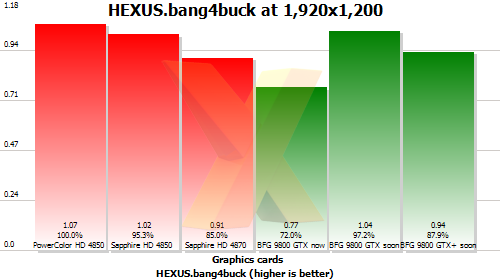HEXUS.bang4buck, temps & overclocking
HEXUS.bang4buck
In a rough-and-ready assessment of the cards' value-for-money, we've aggregated the 1,920x1,200 frame-rates for the four games, normalised them* and taken account of listed the cards' prices.
But, even so, there are more provisos than we'd care to shake a stick at. We could have chosen four different games, the cards' prices could have been derived from other sources and pricing tends to fluctuate daily.Consequently, the table and graph below highlight a metric that should only be used as a yardstick for evaluating comparative performance with price factored in. Other architectural benefits are not covered, obviously.
| Graphics cards | PowerColor Radeon HD 4850 512MiB | Sapphire Radeon HD 4850 512MiB | Sapphire Radeon HD 4870 512MiB | BFG GeForce 9800 GTX 512MiB | BFG GeForce 9800 GTX+ 512MiB |
|---|---|---|---|---|---|
| Actual aggregate marks at 1,920x1,200 | 180.16 | 180.99 | 225.68 | 192.13 | 203.28 |
| Aggregate marks, normalised*, at 1,920x1,200 | 126.12 | 126.51 | 162.71 | 134.17 | 141.51 |
| Current pricing, including VAT | £117.49 |
£124 | £179 |
£129/£175** |
£150*** |
| HEXUS.bang4buck score at 1,920x1,200 | 1.07 | 1.02 | 0.91 | 1.04/0.77** |
0.94 |
| Acceptable frame rate (av. 60fps) at 1,920x1,200 | No (ET, Crysis, LP) | No (ET, Crysis, LP) | No (Crysis, LP) | No (ET, Crysis, LP) | No (ET, Crysis, LP) |
* The normalisation refers to taking playable frame rate into account. Should a card benchmark at over 60 frames per second in any one game, the extra fps count as half. Similarly, should a card benchmark lower, say at 40fps, we deduct half the difference from its average frame rate and the desired 60fps, giving it a HEXUS.bang4buck score of 30 marks. The minimum allowable frame rate is 20fps but that scores zero.
As an example, should a card score 120fps we treat it as 90fps as only half the frame rate above 60fps is counted for the HEXUS.bang4buck - this is the formula: (120-((120-60)/2)). Similarly, should it score 30fps, we count it as only 15fps: (30+((30-60)/2)).
The reasoning behind such calculation lies with playable frame rates.
Should card A score 110fps in a benchmark and card B 160, then card B would otherwise receive an extra 50 marks in our HEXUS.bang4buck assessment, even though both cards produce perfectly playable frame rates and anything above 60fps is a bonus and not a necessity for most.
Similarly, without our adjustments, the aggregated HEXUS.bang4buck total for two very different cards would be identical if, in a further benchmark, card A scored a smooth 70fps and card B an unplayable 20fps. Both would win marks totally 180, yet the games-playing experience would be vastly different.
A more realistic (and useful) assessment would say that card A is better because it ran smoothly in both games - and that view would be accurately reflected in our adjusted aggregation, where card A would receive 150 marks (85+65) and card B 100 (100+0).
In effect, we're including a desired average frame rate, in this case 60, and penalising lower performance while giving frame rates higher than 60fps only half as much credit as those up to 60fps. If this doesn't make sense or you have issue with it, please hit the HEXUS community.
** £129 is the pre-order price price-cut GeForce 9800 GTX. Current pricing is somewhat higher, at around £175, until rolled in by various etailers.
*** This is estimated pricing based on the information we have. Until the product is launched and available take these figures with a grain of salt.
Here's the HEXUS.bang4buck graph at 1,920x1,200.

In terms of value-for-money, the ATI cards match up to the NVIDIA
offerings - even when the upcoming GeForce 9800 GTX price drops are
taken into
account Right now, though, the PowerColor is the best of the bunch,
based on our games' testing..
Across the board we're seeing better value than
ever before. Clearly with such fierce competition we, the consumers,
are the real winners.
Temperature musings
We perform our testing in an open test bed, with a 120mm fan simulating case airflow.
| Graphics cards | Sapphire Radeon HD 4850 512MiB | Sapphire Radeon HD 4850 512MiB | Sapphire Radeon HD 4870 512MiB | BFG GeForce 9800 GTX 512MiB |
|---|---|---|---|---|
| Ambient temperature | 25°C | 21°C | 25°C | 21.5°C |
| Idle temperature | 77°C | 71°C | 71°C | 52.5°C |
| Load temperature | 82°C | 81°C | 83°C | 67°C |
| Ambient-to-load delta | 57°C | 60°C | 58°C | 45.5°C |
We've not included figures for our simulated 9800GTX+ as the actual product will be based upon the more power-efficient 55nm process.
Both idle and load temperatures of the Radeon HD 4800-series cards are considerably high. They need a BIOS fix to set fan speeds to more acceptable levels. However, a workaround is available, as covered here, which should help in the meantime.
Overclocking
With the high temperatures reported due to the fans not spinning up, we
found overclocking headroom on our launch HD 48x0 cards to be
compromised. Despite this we managed to overclock the PowerColor's core
from 625MHz to 700MHz - the maximum available in Catalyst Control
Centre. Memory, however, fared poorly, moving only from 1986MHz to
2010MHz.
These overclocks resulted in Enemy Territory: Quake Wars
frame rates at
1,920x1,200 jumping from 51.63 to 59.20fps, which, on the face of it,
seems like an implausibly high jump.
With the temperature control issue fixed (or an aftermarket cooler installed) and third-party tools supporting greater than 700MHz core speed, We'd imagine there to be more headroom left in the card.









